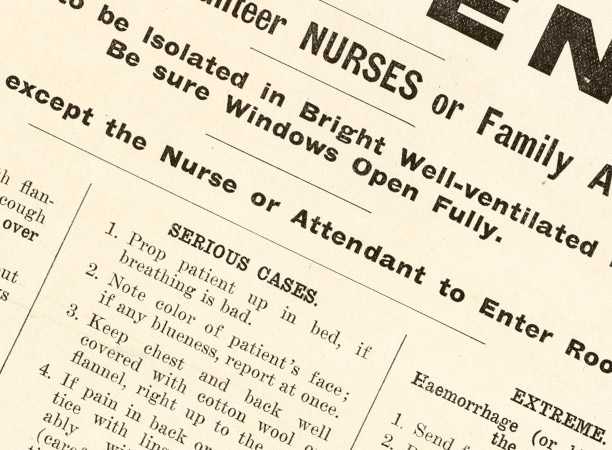
No other event has killed so many New Zealanders in such a short time as the 1918 influenza pandemic.
The second and more deadly wave of a new strain of influenza arrived in New Zealand in October 1918. By the end of the year around 9,000 people across the country had died. Half as many New Zealanders lost their lives in little more than two months than during the entire First World War, and worldwide the pandemic was responsible for at least 50 million deaths.
At the time, many believed that the A(H1N1) virus had arrived on board RMS Niagara, which berthed in Auckland on 12 October 1918 after sailing from Vancouver and San Francisco. But this is no longer thought to be the case. Historian Geoffrey Rice’s analysis of death certificates revealed that peak mortality in New Zealand probably occurred on 23 November – six weeks after the arrival of the Niagara, and several weeks later than would have been expected if the vessel had brought the virus, given its incubation period.
The exact details of the flu’s arrival in New Zealand remain a mystery. However, it was a New Zealand passenger and cargo ship, the Talune, which was responsible for bringing influenza to Samoa on 7 November. Seriously ill passengers were allowed ashore without quarantine and the virus spread quickly. Between one-fifth and one-quarter of the population died as a result, the highest death rate anywhere in the world.
In New Zealand ordinary life ground to a halt as the pandemic peaked. Schools and many workplaces shut down, and towns and cities set up depots to coordinate relief efforts. Preventative measures included restricting the opening hours of public facilities and postponing or cancelling events that would have brought large numbers of people together – including Auckland’s celebration of the armistice with Germany.
Māori were particularly affected by the flu, with a death rate more than eight times that for Pākehā. Military camps and some small towns, such as Nightcaps in Southland, had disproportionately high numbers of deaths. The flu was unusual in that healthy adults had a higher mortality rate than the young and the old. A particularly distressing consequence of infection was that it turned the skin of some of the victims purple–black. This was due to pneumonia, which attacked the lungs after the initial infection and was responsible for most of the deaths.
The pandemic declined rapidly after reaching its peak. In its aftermath the government set up a royal commission which resulted in Robert Makgill’s 1920 Health Act, considered a model piece of legislation at the time. A number of memorials to pandemic victims were erected around the country, including to Māori victims and to the doctors and nurses who lost their lives. Among them was a monument to Margaret Cruickshank, New Zealand’s first female doctor.
Influenza continues to be a significant public health issue in New Zealand, affecting up to 20% of people each year and causing some deaths.
How to cite this page
'Influenza pandemic reaches peak mortality', URL: https://nzhistory.govt.nz/influenza-pandemic-reaches-peak-mortality, (Ministry for Culture and Heritage), updated 3-Nov-2021

Community contributions